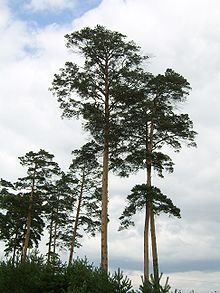Loading AI tools
Species of conifer From Wikipedia, the free encyclopedia
Pinus densiflora, also called the Japanese red pine,[3] the Japanese pine,[4] or Korean red pine,[5] is a species of pine tree native to East Asia and Siberia. In China, the plant is known as 赤松 (pinyin: chì sōng, literally "red pine").
| Pinus densiflora | |
|---|---|
 | |
| Scientific classification | |
| Kingdom: | Plantae |
| Clade: | Tracheophytes |
| Clade: | Gymnospermae |
| Division: | Pinophyta |
| Class: | Pinopsida |
| Order: | Pinales |
| Family: | Pinaceae |
| Genus: | Pinus |
| Subgenus: | P. subg. Pinus |
| Section: | P. sect. Pinus |
| Subsection: | P. subsect. Pinus |
| Species: | P. densiflora |
| Binomial name | |
| Pinus densiflora | |
| Synonyms[2] | |
| |
P. densiflora has a home range that includes Japan, the Korean Peninsula, northeastern China (Heilongjiang, Jilin, Liaoning, Shandong and northeastern Jiangsu) and the extreme southeast of Russia (in Siberia, southern Primorsky Krai).
The leaves are needle-like, 8–12 centimetres (3–4+1⁄2 inches) long, with two per fascicle. The short leaves are 5–6 cm. There are stomatal lines on both sides of the leaf, two vascular bundles, about three to nine resin canals, and fine serrations on the edge of the leaf. Branchlets with more or less white powder. Male cones are light reddish yellow, clustered in the lower part of new branches, female cones are light reddish purple, solitary or clustered in two to three clusters. The cones are dark brown yellow or light brown yellow when mature, they dehiscent at maturity, seed scales usually thin, seed winged. The bark is orange-red, cracked into irregular scale-like pieces. Heartwood reddish brown, sapwood light reddish yellow. The height of the tree is 20–35 metres (66–115 feet). The crown can reach 30 metres (98 feet).[6][7][8]
"The distribution of P. densiflora in China has the following pattern of variation: the more northward it is distributed, the needles are relatively shorter, the white powder on the branchlets is sometimes less obvious or partly obvious, and the color of the cones is lighter. It is light brown yellow".[6]
The cones are 4–7 cm (1+1⁄2–3 in) long. It is closely related to Scots pine, differing in the longer, slenderer leaves which are mid-green without the glaucous-blue tone of Scots pine. This pine has become a popular ornamental and has several cultivars, but in the winter it becomes yellowish. The plant prefers full sun on well-drained, slightly acidic soil.
Strong wind resistance, P. densiflora is an excellent tree species for afforestation in stony mountains, barren soil and sandy land. The timber can be used for construction, electric poles, sleepers, ore pillars, furniture, and wood fiber industrial raw materials. The trunk is rich in resin, from which rosin and turpentine can be extracted. Essential oil can be extracted from the leaves. In northeast China, matsutake relies on P. densiflora for growth. "Jilin Tianfozhishan National Nature Reserve/Jilin Tianfozhishan National Nature Reserve" takes Matsutake, P. densiflora and ecosystem as the main protection objects. P. densiflora wood has natural anti-corrosion and anti-mildew properties, and natural preservatives and natural wood anti-mold agents can be extracted. P. densiflora has non-stinging needles and soft branches, making it easy to shape as a penjing.[6][8]
Seamless Wikipedia browsing. On steroids.
Every time you click a link to Wikipedia, Wiktionary or Wikiquote in your browser's search results, it will show the modern Wikiwand interface.
Wikiwand extension is a five stars, simple, with minimum permission required to keep your browsing private, safe and transparent.